WORLD MISSION SOCIETY CHURCH OF GOD TIMELINE
1918 (January 13): Ahn Sahng-hong was born in Myeongdeok-ri, Jangsu County, North Jeolla Province, Korea.
1937: Ahn moved to Japan.
1943 (October 29): Zahng Gil-jah was born in Korea (for whatever reason, information about her place of birth is regarded as confidential by the Church and not released).
1946: Ahn returned to Korea from Japan.
1947: Ahn started attending services of the Seventh-day Adventist Church in Incheon.
1948 (December 16): According to his own claims, and to the World Mission Society Church of God, Ahn was baptized into the Seventh-day Adventist Church (critics maintain that the baptism in fact occurred on October 9, 1954).
1958 (April 5): Ahn married Hwang Won-sun.
1962 (March): Ahn was excommunicated by the Seventh-day Adventist Church.
1964 (April 28): Ahn established the Witnesses of Jesus Church of God in Busan, South Korea.
1978: Ahn rejected the claims by his disciple Um Soo-in that she was the Bride and the Divine Mother.
1980: The number of churches established by Ahn in South Korea grew to thirteen.
1985 (February 25): Ahn died in Busan.
1985: The followers of Ahn divided between a majority that recognized Zahng Gil-jah as God the Mother, and the leadership of Kim Joo-cheol as General Pastor, and a minority that followed Ahn’s widow and three children.
1985 (June 2): The majority group established in Seoul the Witnesses of Ahn Sahng-hong Church of God.
1997: The Witnesses of Ahn Sahng-hong Church of God changed its name into World Mission Society Church of God (WMSCOG).
2000: Membership in the WMSCOG reached 400,000.
2001: The International We Love U Foundation was founded in Korea.
2003: Volunteer work after the Daegu subway tragedy and at the Daegu Universiade made WMSCOG well-known in Korea for its social welfare activities.
2008: WMSCOG declared that its membership had reached the mark of 1,000,000.
2012: WMSG and its critic clashed in court cases about whether WMSCOG had repeatedly predicted dates for the end of the world.
FOUNDER/GROUP HISTORY
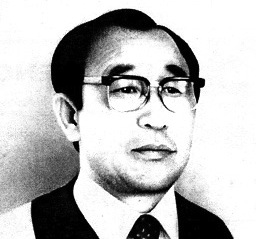
Ahn Sahng-hong [Image at right] was born in Myeongdeok-ri, Jangsu County, North Jeolla Province, Korea on January 13, 1918. He moved to Japan with his mother in 1937. In 1946, he returned to Korea, and in 1947 he started attending services of the Seventh-day Adventist Church in Incheon.
Controversies exist on when he was baptized into the Seventh-day Adventist Church, since for his followers the date has providential significance. WMSCOG maintains that the baptism happened on December 16, 1948. In 2011-2012, however, Christian counter-cultists that regard Ahn’s teachings as heretical, and the Seventh-day Adventist Church itself, claimed that Ahn was in fact baptized on October 9, 1954 (International Korean Christian Coalition against Heresy 2012). WMSCOG answered that both counter-cultists and Adventists have a vested interested in contesting messianic claims about Ahn, for which (as we shall see) 1948 as the date of baptism is crucial, and that the documents exhibited are not persuasive, as they look more as registers of church attendance than of baptisms.
On April 5, 1958, Ahn married Hwang Wonsun (1923-2008), who would become the mother of his three children. He continued attending the Seventh-day Adventist Church, as he was firmly persuaded that the day of the Lord was Saturday and no other church in Korea was 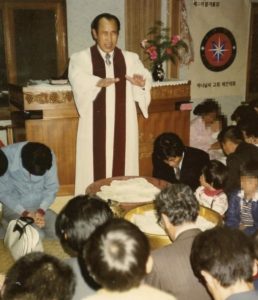 Sabbatarian at that time. However, he gradually came to believe that the Adventists missed other essential points, including the need for celebrating the Passover and for renouncing the use of the cross as a Christian symbol and the celebration of Christmas, both practices he believed to be of Pagan origin. In March 1962, these disputes led Ahn to be excommunicated by the Seventh-day Adventist Church with a handful of followers.
Sabbatarian at that time. However, he gradually came to believe that the Adventists missed other essential points, including the need for celebrating the Passover and for renouncing the use of the cross as a Christian symbol and the celebration of Christmas, both practices he believed to be of Pagan origin. In March 1962, these disputes led Ahn to be excommunicated by the Seventh-day Adventist Church with a handful of followers.
On April 28, 1964, Ahn established the Witnesses of Jesus Church of God in Busan. The church grew and by 1980 counted thirteen local churches in South Korea. [Image at right] In the meantime, Ahn had become involved in 1978 in a controversy with a disciple called Um Soo-in, who claimed that she was the Bride and the Divine Mother. Um also contested Ahn’s teaching that women should attend services of the Church veiled. Ahn wrote a booklet in 1980 to answer Um’s claim and, although initially repentant, she eventually returned to her original positions and was excommunicated.
In the 1980 booklet, Ahn claimed inter alia that there is no Bride and that the Biblical references to a “Bride” should be read as meaning all “the saints” (Ahn [1980] 2012). These words were subject to different interpretations after Ahn 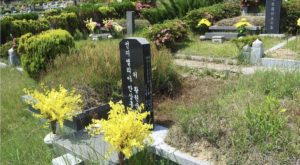 died on February 25, 1985 in Busan. [Image at right] His followers divided between a majority that recognized Zahng Gil-jah as God the Mother, and the leadership of Kim Joo-cheol, and a minority that followed Ahn’s widow and three children. The minority kept the premises in Busan, while the larger faction established new headquarters near Seoul. The minority group later came to be known as New Covenant Passover Church of God (NCPCOG). On June 2, 1985, the majority group established in Seoul the Witnesses of Ahn Sahng-hong Church of God. The latter name was changed in 1997 into World Mission Society Church of God (WMSCOG).
died on February 25, 1985 in Busan. [Image at right] His followers divided between a majority that recognized Zahng Gil-jah as God the Mother, and the leadership of Kim Joo-cheol, and a minority that followed Ahn’s widow and three children. The minority kept the premises in Busan, while the larger faction established new headquarters near Seoul. The minority group later came to be known as New Covenant Passover Church of God (NCPCOG). On June 2, 1985, the majority group established in Seoul the Witnesses of Ahn Sahng-hong Church of God. The latter name was changed in 1997 into World Mission Society Church of God (WMSCOG).
According to the NCPCOG, Ahn’s 1980 booklet criticizing Um Soo-in implies a rejection of the doctrine of the existence of God the Mother and the possibility of her incarnation on Earth. The booklet certainly chastises women who presume to dictate how church members should behave. However, it particularly insists on the need for women to attend services with their head covered by a veil, and denounces Um Soo-in’s “ignorant lies” on this issue (Ahn [1980] 2012). WMSCOG insists that the booklet, whose central focus on the veil issue is often misunderstood, is aimed at criticizing the claims of one particular woman, Um Soo-in, rather than as offering any indication on the question of God the Mother in general. WMSCOG also points out that obviously Um Soo-in misinterpreted teachings she had heard from Ahn (in WMSCOG tradition, it is reported that she found and read confidential material in Ahn’s bag), and this is further evidence that such teachings existed (The True WMSCOG 2012a: this is not an official Web site of the WMSCOG, but does represent views prevailing among its members).
WMSCOG also maintains that, once the Um Soo-in problem was solved, Ahn withdrew the booklet from circulation. Ahn, they argue, “closed the door to the truth about Heavenly Mother in 1983 in order to drive away the hindrance from the false Bride,” although later the door was reopened (The True WSMCOG 2013a). WMSCOG also teaches that the doctrine of the Heavenly Mother had been mentioned by Ahn well before the Um Soo-in episode, in fact “at the beginning of the 1950’s,” and “in His own handwritten notebook, he clearly explained this truth” (Yoon 2010, 158).
Issues between NCPCOG and WMSCOG went beyond the Um Soo-in 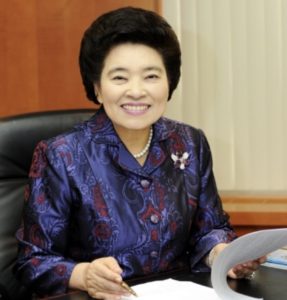 incident. WMSCOG proclaimed that Ahn was actually Jesus Christ and that he recognized Zahng Gil-jah [Image at right] as the Heavenly Mother in 1984. Although Ahn never clearly said that he was Jesus Christ, the Son of God, Jesus of Nazareth himself used a similar veiled language in the Gospel, and close associates of Ahn testified that for its closest disciples it was obvious that, in speaking of the second coming of the Christ, he referred to himself (The True WMSCOG 2013b). WMSCOG members also insist that Ahn, whom they refer to as Christ Ahnsahnghong, recognized Zahng Gil-jah as the Heavenly Mother by moving the celebration of Passover 1984 from Busan to Seoul, where she resided, holding the celebration in a wedding hall and lighting there a blue candle and a red candle, typical of Korean weddings, and taking a picture with Zhang dressed as a bride. He also moved headquarters to Seoul in 1985 and instructed his followers to listen to Zahng, which was very untypical of Ahn when dealing with women (The True WMSCOG 2012b; on Ahn’s reserved attitude about women, see Ahn [1980] 2012). NCPCOG denies both that Ahn was the second coming of Jesus Christ and that there is a God the Mother.
incident. WMSCOG proclaimed that Ahn was actually Jesus Christ and that he recognized Zahng Gil-jah [Image at right] as the Heavenly Mother in 1984. Although Ahn never clearly said that he was Jesus Christ, the Son of God, Jesus of Nazareth himself used a similar veiled language in the Gospel, and close associates of Ahn testified that for its closest disciples it was obvious that, in speaking of the second coming of the Christ, he referred to himself (The True WMSCOG 2013b). WMSCOG members also insist that Ahn, whom they refer to as Christ Ahnsahnghong, recognized Zahng Gil-jah as the Heavenly Mother by moving the celebration of Passover 1984 from Busan to Seoul, where she resided, holding the celebration in a wedding hall and lighting there a blue candle and a red candle, typical of Korean weddings, and taking a picture with Zhang dressed as a bride. He also moved headquarters to Seoul in 1985 and instructed his followers to listen to Zahng, which was very untypical of Ahn when dealing with women (The True WMSCOG 2012b; on Ahn’s reserved attitude about women, see Ahn [1980] 2012). NCPCOG denies both that Ahn was the second coming of Jesus Christ and that there is a God the Mother.
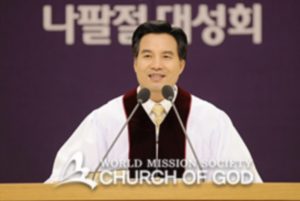
Under the leadership of Zahng Gil-jah and General Pastor Kim Joo-cheol, [Image at right] WMSCOG had an extraordinary expansion within a short period of time. The number of registered members reached 100,000 in 1996, 400,000 in 2000, 1,000,000 in 2008, and over 2,000,000 at the time of this writing (2017), with more than 2,200 churches in some 175 countries of the world. Foreign members visit Korea regularly and the movement points out that they become “ambassadors” for Korean culture abroad and part of a “nongovernmental diplomacy” (Monthly JoongAng Special Reporting Team 2012:149). General Pastor Kim Joo-cheol also operates as a sort of goodwill ambassador throughout the world, liaising with those appreciating WMSCOG’s humanitarian activities. A strong opposition by the Christian counter-cult movement (see below, under “Issues/Challenges”) does not seem to prevent a continuing worldwide expansion.
DOCTRINES/BELIEFS
WMSCOG does not have holy books in addition to the Bible. It claims that all its teachings can be found in the Bible, if it is correctly interpreted. The Church recognizes Ahn, Christ Anhsahnghong, as the second coming of Christ, one with God the Father and identified with the Holy Spirit. WMSCOG finds in the Bible passages hinting at the fact that the second coming of Christ will come from the East, including Matthew 24:27: “For as lightning that comes from the east is visible even in the west, so will be the coming of the Son of Man.” It identifies the East with Korea, a land of prophetic traditions and messianic expectations.
According to WMSCOG, Christ Anhsahnghong fulfilled various Biblical prophecies, but they particularly insist on Christ as the second David. King David was anointed at the age of thirty and reigned for forty years. Jesus of Nazareth was baptized at age thirty and should have preached for forty years. But he was crucified and could preach for only three years. Accordingly, the second coming of Christ should be baptized at the age of thirty and preach for thirty-seven years, completing the forty-years period originally intended for Jesus (World Mission Society Church of God n.d.[a]). For this reason, it is important for WMSCOG to maintain that Ahn was baptized in 1948, at age thirty, and preached until his death in 1985, i.e. for (approximately) 37 years, and it is equally important for WMSCOG’s opponents to challenge the date of Ahn’s baptism.
WMSCOG believes in both God the Father and God the Mother, and claims that this truth is hidden in plain sight in the Bible, with some 2,500 references to a plural God, a divine mother, or Jerusalem identified with a female divine person (Kim 2010:147). When in the Biblical narrative of the creation, God said: “Let us make humankind in our image” (Genesis 1:26), WMSCOG believes that “us” refers to God the Father and God the Mother together, as confirmed by the fact that humans, made “in the image” of God, are male and female. Together with some Biblical scholars, and other new religious movements from both East and West (including the Raelians), WMSCOG interprets the Biblical word “Elohim,” as referred to a plurality of deities. The church also insists on the reference to “the Spirit and the bride” in 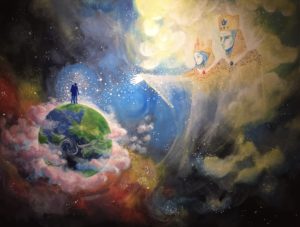 Revelation 22:17. And it sees a clear indication of God the Mother in Galatians 4:26: “But the Jerusalem that is above is free, and she is our mother.” WMSCOG believes that Zahng Gil-jah is the incarnation of God the Mother on Earth, based on what they insist was a clear designation of her as such by Christ Ahnsahnghong in 1984 and 1985. [Image at right]
Revelation 22:17. And it sees a clear indication of God the Mother in Galatians 4:26: “But the Jerusalem that is above is free, and she is our mother.” WMSCOG believes that Zahng Gil-jah is the incarnation of God the Mother on Earth, based on what they insist was a clear designation of her as such by Christ Ahnsahnghong in 1984 and 1985. [Image at right]
God created the souls as angels in Heaven. Those who rebelled against God had to incarnate on Earth, but can return to Heaven by believing in God, Christ Ahnsahnghong and the Heavenly Mother, and practicing their precepts (see below, under “Rituals/Practices”). Thus, WMSCOG teaches the preexistence of human souls in Heaven, although it does not believe in reincarnation. WMSCOG also believes that, after death, the soul sleeps in the grave and will be resurrected in the day of the Final Judgement.
RITUALS/PRACTICES.
In WMSCOG, practicing the correct rituals is essential to gain salvation. It is also important to surrender practices common in traditional Christian churches that are in fact the result of pagan contamination. They include using the cross as a Christian symbol, placing statues in churches as an object of veneration, and celebrating Christmas. Thanksgiving is also regarded as an American human-made feast, which Christian believers would do better to avoid.
Baptism is “our contract with God promising eternal life” (World Mission Society Church of God 2013, 9) and is needed to be saved. WMSCOG administers it in the name of God the Father, Jesus, and Christ Anhsahnghong (who is identified with the Holy Spirit).
One of the core beliefs of WMSCOG is the centrality of Passover. The church shows often the famous mural by Leonardo da Vinci (1452-1519), The Last Supper, pointing out that Jesus and his disciples were not celebrating Easter, but Passover. Only one detail is wrong: “Leonardo da Vinci should have painted the background darker” (World Mission Society Church of God 2013:22), because Passover was celebrated in the evening. According to the Exodus, in the times of Moses, when God struck the Egyptians by killing their firstborns, the Jews were “passed over” by putting the blood of a year-old lamb on their doorframes and housetops. The truth of Passover, according to WMSCOG, was restored by Christ Anhsahnghong, so that even today “disasters ‘pass over’ us. No one can be saved without keeping the Passover” (Yoon 2010:160) at the specific date and time mandated in the Bible.
At Passover, WMSCOG performs two specific rituals. The first is the washing of the feet, and Zahng Gil-jah herself washes the feet of some of her followers at the Korean headquarters. The second is eating the (unleavened) bread and drinking the wine of the Passover, which represent Jesus’ flesh and blood and correspond to the fruits of the Tree of Eternal Life mentioned in the Biblical narrative of the creation. In fact, according to General Pastor Kim Joo-cheol, “the Passover contains the promise of eternal life” and “through this ceremony, we receive God’s flesh and blood and are allowed to call God Father and Mother” (Yoon 2010:160).
It is also important to keep the other Biblical feasts: the Feast of Unleavened Bread, the Feast of Firstfruits, the Feast of Weeks, the Feast of Trumpets, the Day of the Atonement, and the Feast of Tabernacles. WMSCOG is also sabbatarian, and regards as unbiblical the attitude of those Christian churches that moved the day of the Lord from Saturday to Sunday. As important as these prescriptions may be, none equals in centrality for WMSCOG the Passover, which is the only day of the year in which members take communion with bread and wine.
As mentioned in the group history section, Ahn also regarded as very important that women keep their heads covered with a veil during church services. 1 Corinthians 11:4-5 teaches: “Every man who prays or prophesies with his head covered dishonors his head. But every woman who prays or prophesies with her head uncovered dishonors her head.” For WMSCOG, these are direct commands of God, and “if we regard God’s regulations as trivial, God will regard us as trivial” (World Mission Society Church of God n.d.[b]).
ORGANIZATION/LEADERSHIP
Zahng Gil-jah is recognized in WMSCOG as God the Mother and has ultimate authority in matters of doctrine. General Pastor Kim Joo-cheol is in charge of the day-to-day operations of the church, which has a structure including pastors, elders, senior deaconesses, missionaries, and deacons and deaconesses, similar to many other Christian denominations (see Yoon 2010:160).
WMSCOG sends missionaries to almost all countries where this is not legally forbidden by the governments, and in fact is present in some 175 countries, with more than 2,200 churches. In some countries, growth has been particularly relevant. They include Nepal, that General Pastor Kim Joo-cheol himself has mentioned as the “most impressive” success story in WMSCOG (World Mission Society Church of God 2011:26). In general, developing countries, and areas suffering because of poverty or war, have been particularly receptive to the message about the love of God the Mother. But the growth has been rapid also in the United States, with churches established in nearly every State and a membership that includes only a minority of Korean Americans. The majority of American believers is not of Korean descent. Often, WMSCOG does not build its own houses of worship but “takes over the building of the churches that have lost their congregation throughout the world, and use them for their worship places,” respecting and indeed making efforts to preserve the original architecture (Seo 2011:3).
Motherly love is at the core of the message of WMSCOG and the church has built museums 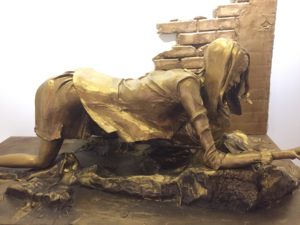 and traveling exhibitions to illustrate the concept in Korea and in New York. [Image at right] Although they conclude by mentioning the mission of Zahng Gil-jah, they are visited every year by thousands who are not members of the church and have won the praise of articles that, although written by journalists who are part of WMSCOG, have appeared in secular publications (see, Han 2014). The church’s concepts of God the Mother and motherly love are also at the center of a number of artistic, theatrical, and musical activities and performances, including those by WMSCOG’s own Messiah Orchestra.
and traveling exhibitions to illustrate the concept in Korea and in New York. [Image at right] Although they conclude by mentioning the mission of Zahng Gil-jah, they are visited every year by thousands who are not members of the church and have won the praise of articles that, although written by journalists who are part of WMSCOG, have appeared in secular publications (see, Han 2014). The church’s concepts of God the Mother and motherly love are also at the center of a number of artistic, theatrical, and musical activities and performances, including those by WMSCOG’s own Messiah Orchestra.
Volunteerism is very important to the church, which sees service to others as a way for people to cultivate their personal maternal spirituality. WMSCOG has engaged in many benevolent, charitable, and ecological activities, from disaster relief to cleaning polluted areas, organizing blood drives, visiting hospitals and nursing homes, and promoting a variety of family and community gatherings. The church has received high praise from these social welfare activities. It has also received the Presidential Award for Voluntary Service in the U.S. in 2011, and the Queen’s Award for Voluntary Service in the United Kingdom in 2016, as well as similar awards in South Korea and Australia (Seo 2016). In 2001, however, it became clear that in several countries it was more difficult to perform service activities under a sectarian label. For this reason, the International We Love U Foundation was incorporated in Korea. Zahng Gil-jah serves as chairwoman of the foundation, which is, however, nonsectarian and includes several leaders and volunteers who are not members of WMSCOG.
ISSUES/CHALLENGES
Although in the United States some “cult experts” and anti-cultists have listed WMSCOG as a “cult,” their understanding of the Korean context of its origins is limited. The main challenges to WMSCOG came from Christian counter-cultists in Korea, who are particularly active in exposing Christian-based new religious movements in Korean as heretical. The International Korean Christian Coalition Against Heresy is one such counter-cult organization that has been particularly active in denouncing WMSCOG’s beliefs in God the Mother and Ahn as the second coming of Christ as heretic, and it has sought the cooperation of Western anti-cultists for warning against WMSCOG’s missionaries.
In 2002, WMSCOG took to court the most famous Korean Christian counter-cultist, Tak Ji-won. In 2005, the Northern Seoul Regional Court found in favor of Tak. The court recognized that Tak’s writings contained “inappropriate,” “excessive,” and “incorrect” statements, but maintained that Tak had good faith reasons to believe that they were true and was acting within the limits of free expression (Northern Seoul Regional Court 2005).
Emboldened by Tak’s legal resistance and, later, success in court, and relying largely on his writings and those of the International Korean Christian Coalition Against Heresy, relatives of WMSCOG members, led by a Mr. Jeong, whose wife had joined the church and divorced him, continued a strong-worded campaign against WMSCOG. Four of them, including Jeong, were in turn sued by WMSCOG, and the case went all the way to the Korean Supreme Court. On November 23-24, 2006, the Supreme Court found in favor of WMSCOG and against Jeong and his co-defendants, declaring the allegations they had brought against the church as untrue. The Supreme Court also noted that Jeong and the pastor of his Christian church, a so called “heresy expert,” were engaged in the illegal practice of deprogramming, and Jeong had unsuccessfully tried to deprogram his wife. Jeong’s wife was held prisoner in the “heresy expert’s” church and later, illegally, for eighty-five days in a mental institution (“The Supreme Court ruled that ‘the insistence that the Church of God spread a time-limited eschatology and causes families to break up is false’” 2006: the article is from a Korean Christian newspaper not associated with WMSCOG).
A key theme of these court cases was whether WMSCOG had announced the end of the world repeatedly for 1998 and 1994 and, at the time of the trials, had jumped on the bandwagon of the widespread predictions of the end of the world for 2012. In the Tak case, the judges were less certain about 1998 and 2012. Perhaps, they noted, only some members “within the church” believed in doomsday predictions for these dates, rather than WMSCOG as a whole (Northern Seoul Regional Court 2005). But they believed Tak had found a flyer where the church announced the end of the world for1988. The document claimed, in Korean and English, that “1988 is the end of the world,” and is kept on the Web by Korean counter-cultists to this date (“1988 is the End of the World” n.d.).
WMSCOG members, however, as evidenced in interviews we conducted at the church’s New York premises, maintain that the document is false and was fabricated for the purposes of the Tak litigation, as evidenced inter alia by the fact that directions to the services of the church in its back part were wrong. In the end, the Supreme Court decision in the case of Jeong and others accepted the church’s claim that it had never announced dates for the end of the world and, if some members did, they were counseled to put their trust in the celebration of the Passover, which would save them from any disaster, apocalyptic or otherwise.
While the usual arguments against “cults” have also been used against WMSCOG, ultimately the core of the opposition against the church is represented by Christian pastors and other activists. For them, the idea that, in addition to God the Father, there is a God the Mother and is a living Korean woman, and the mission of Jesus Christ needed to be completed by a second Christ who lived in Korea in the twentieth century, can only be regarded as heretical and offensive to Christianity. WMSCOG is aware of the need to demarcate their own beliefs and practices from Unificationism, another Korean tradition that has now a female leader who claims for herself a messianic role. But oppositions and misperceptions do not seem to have 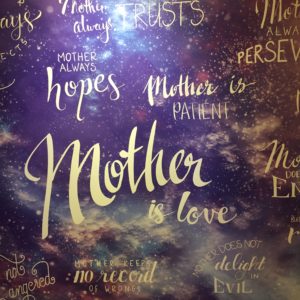 hindered the progress of WMSCOG, as even in areas with a Christian majority, such as United States or Peru (another country where the church has been quite successful), the announcement that a God the Mother is ready to offer her motherly love seem to resonate with the aspirations and needs of many. [Image at right] As for Korea, Christian “heresy hunters” continue to denounce WMSCOG and other new religions, but the church’s social welfare activities (particularly after its relief work following the Daegu subway tragedy 2003 and the cooperation of its volunteers with the Daegu Universiade in the same year) have made WMSCOG increasingly accepted as a legitimate part of the Korean multifaceted religious landscape.
hindered the progress of WMSCOG, as even in areas with a Christian majority, such as United States or Peru (another country where the church has been quite successful), the announcement that a God the Mother is ready to offer her motherly love seem to resonate with the aspirations and needs of many. [Image at right] As for Korea, Christian “heresy hunters” continue to denounce WMSCOG and other new religions, but the church’s social welfare activities (particularly after its relief work following the Daegu subway tragedy 2003 and the cooperation of its volunteers with the Daegu Universiade in the same year) have made WMSCOG increasingly accepted as a legitimate part of the Korean multifaceted religious landscape.
IMAGES
Image #1: Ahn Sahng-hong.
Image #2: Ahn Sahng-hong preaching in his newly established church.
Image #3: The grave of Ahn Sahng-hong.
Image #4: Zahng Gil-jah.
Image #5: General Pastor Kim Joo-cheol.
Image #6: Christ and Mother in the Church’s visual art.
Image #7: Sculpture by Luis Figueroa in the Church’s New York museum.
Image #8: Celebrating motherly love in the New York Museum.
REFERENCES
“1988 is the End of the World” n.d. Accessed from https://docs.google.com/file/d/0B-VK7RLDRwS4NWF6Q0lGVUJUTFU/edit (front) and https://docs.google.com/file/d/0B-VK7RLDRwS4X21OQmQ4bGRVeHc/edit (back) on July 21, 2017.
Ahn, Sahng-on. [1980] 2012. Interpretation on the New Jerusalem and the Issue of the Head Covering of Brides. English translation on the Web site of the New Covenant Passover Church of God. Accessed from http://ncpcog.co.kr/rb/home/b/0604/441 on July 21, 2017.
Han, Kihong. 2014. “The Power of Motherly Love.” Newsweek (Korean edition), June 28, 64-67.
International Korean Christian Coalition against Heresy. 2012. “안상홍 교적부 있는 부산 해운대안식일교회” (in Korean). Accessed from http://ikccah.org/news_ikccah/298 on July 21, 2017.
Kim, Joo-cheol. 2010. “Mother”: The Mystery of the Bible. Bundang: WATV.
Monthly JoongAng Special Reporting Team. 2012. “‘Mother’s Land, Wonderful!’” Great Role of Nongovernmental Diplomacy.” Pp. 149-51 in World Mission Society Church of God, The World Mission Society Church of God Catches the Attention of the World: “We Are Happy Because We Have ‘Mother’.” New York: World Mission Society Church of God, U.S. East Coast.
Northern Seoul Regional Court. 2005. Church of God World Gospel Association v. Ji Won Tak. Decision of July 8, 2005. Korean text and English translation accessed from https://docs.google.com/file/d/0B-VK7RLDRwS4S1ktblozc1FabVk/edit on July 21, 2017.
Seo, Cheol-in. 2016. “‘They Simply Engender Happiness.’” Newsweek (Korean edition), August 1, 50-55.
Seo, Cheol-in. 2011. “The Church Buildings Are Beautiful Because the Architectural History Is Not Changed.” Pp. 2-5 in World Mission Society Church of God, Research on a Unique Religion: “We Believe in God the Father and God the Mother on the Basis of the Records in the Bible,” New York: World Mission Society Church of God, U.S. East Coast.
“The Supreme Court ruled that ‘the insistence that the Church of God spread a time-limited eschatology and causes families to break up is false’.” 2006. Christian Newspapers, December 11, 14.
The True WMSCOG. 2013a. “Ahnsahnghong’s Book against Mother God.” Accessed from https://www.thetruewmscog.com/ahnsahnghongs-book-vs-mother-god/ on 21 July 2017.
The True WMSCOG. 2013b. “How Did Ahnsahnghong Say He was Christ?” Accessed from https://www.thetruewmscog.com/how-did-ahnsahnghong-say-he-was-christ/ on 21 July 2017.
The True WMSCOG. 2012a. “Did Christ Ahnsahnghong Say: ‘There’s no Heavenly Mother’?” Accessed from https://www.thetruewmscog.com/christ-ahnsahnghong-no-bride/ on 21 July 2017.
The True WMSCOG. 2012b. “Heavenly Mother, How and When Was She Revealed?”. Accessed from https://www.thetruewmscog.com/year-of-heavenly-mothers-appearance/ on 21 July 2017.
World Mission Society Church of God. 2013. Today is a New Beginning. New York: World Mission Society Church of God, U.S. East Coast.
World Mission Society Church of God. 2012. The World Mission Society Church of God Catches the Attention of the World: “We Are Happy Because We Have ‘Mother’.” New York: World Mission Society Church of God, U.S. East Coast.
World Mission Society Church of God. 2011. Research on a Unique Religion: “We Believe in God the Father and God the Mother on the Basis of the Records in the Bible.” New York: World Mission Society Church of God, U.S. East Coast.
World Mission Society Church of God. n.d.[a]. “Text Sermon: Seek David in the Last Days.” Accessed from http://english.watv.org/truth/sermon/content.asp?idx=1433 on 21 July 2017.
World Mission Society Church of God. n.d.[b]. “Veil.” Accessed from http://text.watv.org/english/truth/view.html?idx=238 on 21 July 2017.
Yoon, Seok-Jin. 2010. “Heavenly Mother’s Love Has Reached Heaven: Interview with Chief Pastor Kim Joo-cheol.” Pp. 154-61 in Kim Joo-cheol, “Mother”: The Mystery of the Bible, Bundang: WATV.
Post Date:
13 October 2017
